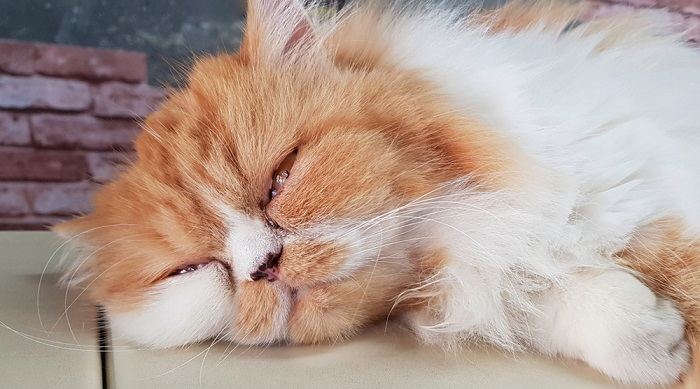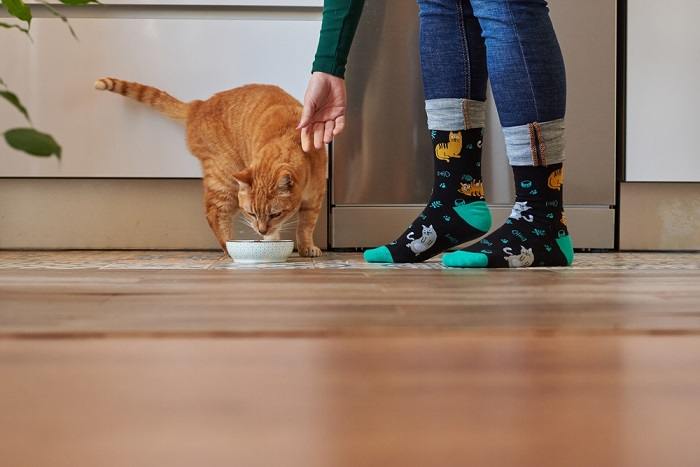
Bordetella in cats, also known as Bordetellosis, is a respiratory disease caused by a bacteria called Bordetella bronchiseptica.
Quick Overview: Bordetella in Cats








How Common Bordetella Is
Bordetella bronchiseptica is a common bacteria in the feline population. The bacteria can be isolated from healthy cats as well as sick cats, but at a much lower prevalence.
For example, in one study of cats (both healthy and unhealthy) from a general population, just 11% had evidence of Bordetella infection, while in studies that included just cats with upper respiratory tract disease, around 45% of cats were found to be infected.
Why the Disease Is Called Bordetella or Bordetellosis
Feline bordetellosis describes the condition when a cat is infected with the Bordetella bronchiseptica bacteria.
The condition is named after the causative pathogen, Bordetella bronchiseptica, which is a “gram-negative, obligate aerobic coccobacillus.”
- Gram-negative means that Bordetella does not pick up the gram stain when being examined under the microscope. This fact has implications when deciding which antibiotic to use (some are more effective against “gram-positive” bacteria, while other antibiotics work better against “gram-negative” bacteria).
- Obligate aerobic means that Bordetella needs oxygen to survive (compared to “anaerobic” bacteria which can thrive without oxygen). This fact has implications for the types of areas in the body where Bordetella is found.
- “Coccobacillus” describes the shape of Bordetella under the microscope. A “coccus” is spherical, a “bacillus” is rod-shaped, and a “coccobacillus” is a combination of the two shapes.
How Cats Get Bordetella
Cats usually become infected after direct contact with another infected cat that is shedding the bacteria, usually in respiratory secretions, such as coughing or sneezing. It’s also possible for the bacteria to be passed on via fomites (i.e., objects in the environment, such as food bowls, bedding, etc).
The Clinical Signs of Feline Bordetella
Cats infected with B. bronchiseptica tend to develop the signs of upper respiratory infection (URI), as follows:
- Tracheobronchitis (inflammation of the larger airways), often causing a whooping cough
- Conjunctivitis (inflammation of the conjunctiva, which is the lining of the eyes), causing redness of the eyes, ocular discharge, and discomfort.
- Rhinitis (inflammation of the lining of the nose) causing sneezing and nasal discharge.
- Sometimes, this extends to pneumonia, which means severe inflammation of the lungs in which the alveoli (tiny air sacs) are filled with fluid.
- Mandibular lymphadenopathy (enlargement of the lymph nodes under the lower jaw)
- Non-specific signs that may be seen include inappetence, fever, and dullness.
Also Read: 10 Subtle Signs Your Cat May Be Sick
Other Possible Causes of These Signs of Illness

Be aware that symptoms typical of Bordetella can actually point to other types of respiratory infections.
Other possible causes of similar signs of upper respiratory infection include:
- Feline calicivirus (FCV)
- Feline herpesvirus (FHV)
- Chlamydophila felis
- Feline mycoplasma
Diagnosis of Feline Bordetella
If your DVM veterinarian suspects that your cat may have Bordetella Bronchiseptica infection, the following steps may be taken.
1. Detailed History Taking
Your vet will discuss every aspect of your cat’s life, background, and health care. This will include asking questions about contact with other cats, vaccination history, and daily habits such as eating, drinking, defecation, urination, etc.
2. Physical Examination
Your veterinarian will check your cat over carefully, noting any physical signs of illness, ruling out other causes of the signs that are being shown. This will usually include listening to the cat’s chest with a stethoscope, taking their temperature, closely examining their head and body, and checking their eyes, nose, and mouth in detail.
3. Routine Blood Tests
Your veterinarian may suggest blood tests, including the usual panel of diagnostic tests, such as hematology (blood count) and biochemistry profiles, to confirm that there is no other underlying cause making your cat ill. Bordetella does not cause specific changes in these tests.
4. X-rays
X-rays may or may not be recommended. They will be normal in most cases, although they may show signs of change if a cat has developed pneumonia. Such changes are not specific to Bordetella.
Examination of Samples Collected From Airways
Your vet may collect samples (swabs) from your cat’s airways (mouth, nose, windpipe) and examine these in to look for evidence of B. Bronchiseptica infection:
- Cytology means looking at the cells in the samples under the microscope. If Bordetella is present, the bacteria may be visible, along with white blood cells (neutrophils) which represent part of the body’s immune system response to the infection
- Bacterial culture may be carried out, and the Bordetella bacteria may be grown in the laboratory. Samples collected from deeper airways (bronchi, trachea) collected by lavage are more likely to be significant while samples from the upper airways (mouth, nose, eyes) are likely to be contaminated with bacteria of no significance to the illness.
- Polymerase Chain Reaction (PCR) testing may be used to demonstrate genetic evidence of the Bordetella bacteria antigen.
Treatment of Feline Bordetella

Medication for cats suffering from Bordetella may be necessary and is generally straightforward to use.
Antimicrobial drugs are the primary treatment for Bordetella. These are prescription-only medicines, and your veterinarian will decide which specific antibiotic to use, ideally based on susceptibility identified from cultures.
Common choices include doxycycline, tetracycline, enrofloxacin, and trimethoprim-sulfamethoxazole. These may be given for a variable period of between 7 and 21 days, depending on the clinical details of the case.
Ancillary nursing care, such as cleaning away discharge, tempting your cat to eat warm, tasty food, and maintaining fluid intake, is also important.
Prognosis for Cats With Feline Bordetella
Most cats with B. bronchiseptica infection respond well to treatment, making a full recovery. However, in severe cases, especially in cats with compromised immune systems (such as young kittens, older cats, or cats with other issues such as FIV infection), severe life-threatening pneumonia is possible. Natural antibodies play an important part in recovery from B. bronchiseptica, and immunocompromised cats are less effective at producing these.
Prevention of Feline Bordetella
An intranasal Bordetella vaccination is available for cats in some jurisdictions. This may be recommended for cats at particular risk of infection, such as those in catteries, animal shelters, breeding establishments, or other high population density situations. This is regarded as a non-core vaccine i.e. it is not recommended as necessary for all cats.
As with any other infectious disease, any cats showing signs of upper respiratory disease should be isolated from other cats to reduce the spread of the causative organism (whether Bartonella or one of the other possible viral or bacterial infections). Appropriate use of disinfectants should also be implemented in the surroundings (e.g. surfaces, food, water bowls, etc).
B. bronchiseptica can be transmitted from infected dogs (with “Kennel Cough”) to cats, so dogs that are suspected to have this infection should be separated from cats.
Also Read: Cat Vaccinations: What You Need To Know?
Humans and Feline Bordetella
This is a potential zoonotic infection. There are rare instances of humans picking up B. Bronchiseptica from cats, so sensible hygienic precautions should be taken to minimize this risk (e.g. avoiding close contact), especially for immunocompromised humans.
Conclusion

Taking good care of your cat’s basic needs during treatment for any illness is an important aspect of recovery.
Bordetella bronchiseptica infection in cats is a significant cause of respiratory disease. Once diagnosed, treatment is usually straightforward and effective.
Also Read: Why Is My Cat Sniffing Everything All Of A Sudden?
Frequently Asked Questions
Will Bordetella in cats go away on its own?
Cats with fully competent immune systems may be able to deal naturally with mild manifestations of Bordtella bronchiseptica infection (e.g. just a mild sneeze and occasional cough) but if the signs are significant, especially if a cat is dull and not eating, then a timely visit to the vet is very important.
Can my cat give me Bordetella?
Rarely, humans can pick up B. Bronchiseptica from cats, so sensible hygienic precautions should be taken to minimize this risk (e.g. avoiding close contact with affected cats, washing hands after handling them if contact cannot be avoided), especially for immunocompromised humans.
How is Bordetella diagnosed in cats?
A specific diagnosis requires laboratory examination of samples collected from a cat’s airway. Often, a presumptive, clinical diagnosis may be made by a veterinarian based on the signs shown by the cat, without going as far as taking samples for a definitive diagnosis.







